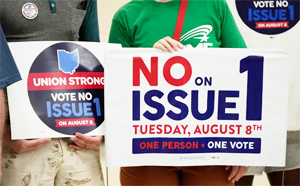 By DemocracyIssues.com, an Ohio-based Voter Rights initiative
By DemocracyIssues.com, an Ohio-based Voter Rights initiative
Over 250+ organizations in Ohio have organized to oppose Issue 1
In spite of Ohio voters passing a Constitutional Amendment in 2015 to end
gerrymandering, and in spite of multiple Ohio Supreme Court orders to do so,
the GOP-controlled Ohio Redistricting Commission has ignored and refused to
remove the current gerrymandered district maps.
The law in Ohio and many other states permits ordinary citizens the right to
organize and place a ballot issue before voters to change the state’s
constitution. With this right, if citizens believe that a law needs to
change, they can undertake a Constitutional Amendment by placing a ballot
issue on an upcoming election through a very challenging process.
Major Ohio Voter Rights organizations and many of their supporters are
currently examining an effort to organize a Constitutional Amendment to end
gerrymandering in the state. The Ohio Supreme Court ruled that gerrymandered
districts are unconstitutional since they deprive many voters of their right
to vote by rigging in advance the outcome of an election in favor of the
political party in control of setting up the district maps.
This is the reason why Ohio Voter Rights organizations are exploring another
citizen-led Constitutional Amendment that would permanently end
gerrymandering.
In order to insure in the future that a citizen-led ballot issue does not
succeed in ending gerrymandered election districts, Ohio Politicians passed
legislation and then placed Issue 1 on the ballot that will make it almost
impossible to pass a new Constitutional Amendment.
One of the requirements of Issue 1 is to raise the threshold for passage
from the current 50 percent of the votes, to instead, 60 percent. This will permit a minority of 40 percent of the voters to control the outcome of any citizen-led ballot issue.
As soon as Ohio law makers introduced the legislation in the General
Assembly behind Issue 1, over 250+ organizations joined a coalition to
oppose this proposed Constitutional Amendment.
Past Ohio governors oppose Issue 1
An article published on June 27, 2023 by Avery Kreemer in the Dayton Daily
News was titled Former Gov. Taft: Issue 1 is ‘state leaders trying to game
the system– and it stated:
“A former Republican Ohio governor (Bob Taft) has taken to the road to
restate his opposition to State Issue 1, the proposal to make it harder to
amend the state constitution . . .
“This is a fundamental change in Ohio’s voting rights,” Taft said,
leaders-trying-to-game-the-system, according to
the Dayton Daily News . . . “I just think it’s a major mistake to approve or
disapprove such a change at the lowest-turnout election (August) that we
have.”
In an article in the Toledo Blade by Jim Provance, comments from former
Republican Governor John Kasich were shared:
“John Kasich, Republican governor from 2011 to 2019, tweeted that it would
never have occurred to him to try such a move.
“Ohio is stronger when we can all lend our voices and we all have an equal
chance to participate in the work of our state’s democracy.”
Provance also shared comments from former Democratic Governor Ted
Strickland:
“Ted Strickland, Democratic governor from 2007 to 2011, told The Blade the
maneuver is “dishonorable, despicable, and hypocritical.”
“Just a few months have passed since they passed legislation regarding
August initiatives being prohibited except in rare circumstances, and now,
when they are afraid that Ohio women are going to establish in our
constitution their right to control their own bodies, they are in a panic,”
he said. “They want to keep that from happening. “Everybody knows what is
happening.”
In addition to the strong opposition by former Governors Bob Taft, John
Kasich, and Ted Strickland, a fourth former Ohio Governor, Dick Celeste, has
also voiced strong opposition to Issue 1.
Past Ohio Attorney Generals oppose Issue 1
Five former Ohio Attorney Generals (Richard A. Cordray, Lee I. Fisher, Betty
D. Montgomery, James M. Petro and Nancy H. Rogers) came together and issued
a strongly worded joint letter opposing Issue 1:
“. . . If the increase in the passing percentage had been in effect, many
important amendments that are part of our political heritage would have
failed, including the initiative and referendum, home rule, civil service
reform, the Clean Ohio Fund, the Third Frontier Project, and other important
bond issues to support economic development, conservation, and housing.
“. . . The 60% proposal is bad for Ohio, and the General Assembly should not
place this proposal on the ballot; but if they do, Ohio voters should reject
this effort to change a fundamental element of our state constitution that
has been in effect for more than 100 years.”
